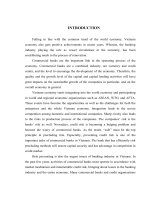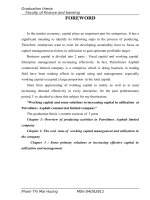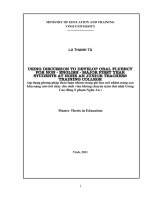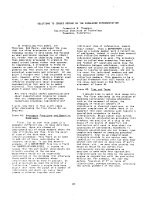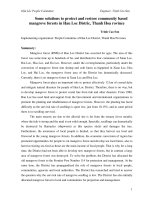Solutions to develop Sweet fashion products till 2010
Bạn đang xem bản rút gọn của tài liệu. Xem và tải ngay bản đầy đủ của tài liệu tại đây (271.05 KB, 41 trang )
1
MINISTRY OF EDUCATION & TRAINING
HO CHI MINH CITY OPEN UNIVERSITY
UNIVERSITE’ LIBRE DE BRUXELLES
SOLVAY BUSINESS SCHOOL
MBMM PROGRAM
NGUYEN THI HONG MAI
Solutions to develop Sweet fashion products
till 2010
FINAL PROJECT
MASTER IN BUSINESS & MARKETING MANAGEMENT
TUTOR:
Prof.PhD
P
Ho Chi Minh City
2007
2
COMMITMENT
I assure this is a project of mine.
All data, results mentioned in project are righteous
NGUYEN THI HONG MAI
3
ACKNOWLEDGEMENTS
I am grateful for being with MBMM program.
I would like to thank Solvay University and Ho chi minh Open
University co-organizers this program and their professors who gave me
updated knowledge and experiences on modern marketing in practice.
I would like to thank professor Nguyen Thi Lien Diep – my tutor who
enthusiastically helps me in orientation, finding the objectives and instructs me
in project realization process.
I would like to thank Ms Do Thi To Nga – S-fashion General manager
for her direction and experimental advices.
Many other colleagues and friends made significant contributions on
this project. Extra special thanks are due to preparers of ancillary materials.
I would also like to thank the good people who spent time on answering
my questionnaire. Their contributions have particular role in success of this
project.
Last but not least, I would like to thank my family and friends for
sticking by me during this project.
Hochiminh City May/2007
Nguyen Thi Hong Mai
4
TUTOR’S COMMENTS
Ms. Nguyen Thi Hong Mai has proved her business analysis capacity in
scrutinizing the status-quo of Sweet brand products in the market. Objective
assessments on environmental impacts on the products, together with
particular collection of customer information are crucial for a business to see
the solutions to develop its products and widen the market share. Ms. Hong
Mai was successful to do so. Feasible solutions, therefore, have been
recommended by her to build up strategy for Sweet branding.
With neat and concise structure, diversified data inputs and in-depth
analyses, the project is graded 36/40. Ms. Hong Mai is recommended to
defend her Final Project of “Solutions to develop Sweet Fashion Products
till 2010” before the Committee.
HCMC, May 21, 2007
Prof. PhD. Nguyen Thi Lien Diep
5
MENTOR’S COMMENTS
S-Fashion Corporation appreciates what Ms. Nguyen Thi Hong Mai
is contributing in the strategy building of the company till 2010. As
a start-up company, it is a rare opportunity that S-fashion receives
such in-depth analysis of its products status in the market. The
possible environmental impacts on the products are also pointed out,
which helps the company see its strengths and weaknesses. At the
same time, very effective solutions have been suggested by Ms.
Mai that helps our company develop our products in the market. We
wish her all the best and success in her study and career.
Ho Chi Minh City, May 23, 2007
Do Thi To Nga
6
CONTENT
EXECUTIVE SUMMARY
INTRODUTION 1
CHAPTER 1: S-FASHION 3
1.1 Establishment 3
1.2 Business Scope 3
1.3 Legal capital 3
1.4 Organization 3
1.5 Marketing mix 4
1.5.1 Product 4
1.5.1.1 Sorts 4
1.5.1.2 Style 4
1.5.1.3 Designs 4
1.5.2 Price 5
1.5.3 Promotion 5
1.5.4 Distribution 5
1.6 Production 5
1.7 R&D 5
1.8 Customers 6
1.9 P&L the last 8 months 6
1.10 The Strengths and weaknesses of S-Fashion 6
CHAPTER 2:
7
2.1. The Macro Environments 7
7
2.1.1. Demand and demand trends 7
2.1.2. Economic environments 7
2.1.3. Political environments 9
2.1.4. Social and culture factors 9
2.1.5. Demographic 10
2.1.6. Natural environments 11
2.1.7. State of technology 11
2.2. The micro environments 12
2.2.1. Customers 12
2.2.2. Competitors 14
2.2.2.1. Nem 14
2.2.2.2. Xinh 14
2.2.2.3. Pierre Cardin 15
2.2.3. Alternatives 16
2.2.4. Suppliers 16
2.3. Opportunities and threats 17
CHAPTER 3: SOLUTIONS 18
3.1 Goals and missions 18
3.2 Some proposal solutions 18
3.2.1 Build a appropriate organization structure 18
3.2.1.1 Set up marketing department 18
3.2.1.2 Build up organization culture 19
3.2.2 Consolidate marketing mix strategy 20
3.2.2.1 Products 20
3.2.2.2 Branding 21
8
3.2.2.3 Services 22
3.2.2.4 Price 23
3.2.2.5 Promotion 23
3.2.2.6 Distribution 23
3.2.3 Find stable material sources 24
CONCLUSION AND RECOMMENDATIONS 25
REFERENCES
TABLES
FIGURES
PICTURES
APPENDIX
9
ABBRIEVIATIONS
CEO chief executive officer
CMO chief marketing officer
EDI electronic data interchange
GDP Gross domestic product
HCMC Ho Chi Minh city
PC Pierre Cardin
POS point of sale
R&D research and development
Savico Saigon General Service Corporation
SKU stock keeping unit
SME small to medium –sized enterprise
SWOT Strengths, weaknesses, opportunities, and threats
TQM Total quality management
VAL Value and Lifestyle
VND Vietnamese dong
WTO World Trade Organization
10
LIST OF TABLES, FIGURES, PICTURES, APPENDIXES
TABLES
Table 1: Balance Sheet
Table 2: P&L
Table 3: Monthly Average Income Per Capita
Table 4: National Statistics Socio-Economic Classification
Table 5: Female employees in enterprises
FIGURES
Figure 1: Level of Needs in The Maslow Hierarchy
Figure 2: In urban Vietnam, Income is Sharply Raising
Figure 3: Young population
Figure 4: Potential Consumers per age Group
Figure 5: VALS 2 Segmentation System
Figure 6: Organization Culture Types
Figure 7: Creating a Relationship Web
PICTURES
Pictures 1-5 Example of Nem Products
Pictures 6-10 Example of Pierre Cardin Products
Pictures 1-5 Example of Sweet Products
APPENDIXES
Appendixes 1: Theoretic
Appendixes 2: Questionnaire
Appendixes 3: The survey results
Appendixes 4: The main target of HCMC
11
S-fashion is a new established company that produces Sweet fashion brand.
Sweet will be an upscale fashion shops located in big cities such as Ho Chi Minh
City (HCMC), Hanoi, Vungtau, Haiphong, Danang…, and will be target females
at the over -30 age group. This shop will offer all kind of office attires. The
decision to target the over 30 market was made so as to capitalize on the ongoing
transition of the fashion industry from an industry that primarily targeted the 20s,
to one that focuses on the over 30s. Currently, an increased emphasis is being
placed on enhancing the quality of life for seniors through the use of specially
designed clothes. Researcher have found fashion to be very effectively in
improving self-esteem as one moves into the brightest years of his life.
The main differential advantages offered by Sweet products will be the
simple French style fashion, professional cuttings and embrace cups taken out
body to create curves that highlight feminine beauty; ethic crotchet and/or
embroider vignettes and good services. The aging of population, an increasing
income and the lack of another such upscale products will contribute to the
success of the Sweet. S-fashion is expected to have a potential market of three
thousands people (just account for HCMC). These potential clients will be
working female of higher and lower managerial staff and professional class, over
30s, and have annual income of 90 millions VND ($ 6,000) and up, geographically
located at most developed cities.
The costs of Sweet shop in HCMC are estimated 51 millions VND/ month.
The shop will break even with 184 units sold out and is expected to achieve this
within the first year.
12
Strengths of S-fashion includes product quality; qualified and more than 20
year experienced designers, tailors and embroiderers, well trained sale staff;
already set up and sustained client source. But on the other hands, weaknesses of
S-fashion include many organization and production shortcomings, limitation on
financial capacity and absence of electronic data interchange (EDI), too few point
of sales in HCMC.
In middle-up office attire segment there are three main competitors Nem,
Xinh, Pierre Cardin. Their positions from high to lower are Pierre Cardin’s,
Sweet, Nem and Xinh. Pierre Cardin soon comes out of market so Sweet tries to
cover its share. It is possible since S-fashion is Pierre Cardin’s producer.
In considerations with opportunities and threats that Sweet may face, the
writer propose some goal and missions for S-fashion in the year 2007 and till 2010
such as improve production, expand market, build strong brand, set up marketing
department, CRM system and build up organizational culture. There are three
main proposed solutions: Build appropriate organization structure, consolidate
marketing mix strategy and find stable material sources. In order to cope with
counterfeit and copyright infringement S-Fashion should change design
continuously and shorten product life cycle. Besides, S-fashion has to diversify
product, widen product ranges and try to be different from the others by using
ethnic elements. In short, Sweet product aim to create female beauty with it own
nature and attractive feminine curves that much differ from old office uniform. S-
fashion should create customer service culture in order to make customers extra
satisfied.
Due to limited time line, writer just proposed solutions mainly for product
and service. The detail plan should be developed as soon as possible to realize
the business ideas. The writer also recommended that S-fashion should diversify
13
of product lines to sport wear and socks and pay much attention on human capital
building for steadily development.
14
Vietnam is thriving to enter the world economy. During the last decade, the
annual economic growth rate has been consistently 8%. As from 2006, Vietnam
becomes the 150
th
official member of the WTO. Such event brings in enormous
opportunities as well as challenges for the local enterprises.
Along with the fast economic growth, demand of local people also
increases, particularly for high-end and luxurious products and services. High-end
fashion can serve as a good example here. Fashion has always been headline in
daily life, particularly for women. It is extremely important for successful women
who start to get their career with certain position in the society, good income and
stable family life.
I myself am one of them, who decided to start my own fashion brand based
on self experience in fashion industry. After a while experimenting small scale
production, I and some friends set up one company and developed high-end office
attire products for over 30 women. The challenge is always how to make the
brand a good choice of customers amongst too many other brands. This is the
reason why I select the topic of “
Solutions to develop Sweet Fashion Product till
2010”
for my final project.
This project will include an analysis of consumer behaviors, market
situation, competitors and company environments; the target market to be
reached; opportunities and threats faced by Sweet Fashion Corporation; and
recommendations for solutions to develop Sweet fashion products;
15
A time constraint of 250-300 hours to finish the entire project causes the
content and detail of the project to be narrowed down in focus. Therefore only
solutions of product development can be developed.
In order to collect necessary data for assessment, analysis and
recommendations of feasible solutions for the product development, the writer
has used methodology of survey, expertise, analysis, comparison and synthesis.
16
S-fashion was officially established in March 2007.
Headquarter is located at 25/2I Thong Nhat, 16 ward, Govap District, HCMC.
S-fashion was founded based upon a joint-venture enterprise which started
in 2004, providing two fashion brands: Pierre Cardin – licensee of Pierre Cardin
Paris - and Em Paris. In March 2006, the enterprise was broke up because of
some irresolvable inconsistencies within its partners. When the idea of a similar
business model was launched, nearly all existing staffs were willing to stay and
work for the new company. A new company was set up, continuing to process
Pierre Cardin for Savico (the Vietnamese principal of the previous joint-venture),
and on the other hand develop a new fashion brand- Sweet. In August 2006, the
first Sweet shop was opened.
production and trading of clothes, fashion commodities,
glasses, footwear and handbags.
1.2 billion VND (75.000USD), working capital at the end
of April was more than 50 million VND.
(See table 1: Balance sheet at
30/04/2007)
. With limited financial capacity, S-fashion has faced many
difficulties.
S-fashion is a small corporation with 40 workers, 4
managers, and 4 sale staffs.
17
1.5.1.1 Sort
: Sweet pays much attention on office apparel for women line.
It includes costume with pants or skirt, trousers and shirts, trousers, pullovers that
can be worn under coat. There is a number of casual wears at weekends or for
going out. In addition, there are simple dresses that may be used in office and
after-office informal parties.
1.5.1.2 Style
: Sweet has French style: modern, simple but plush, serious but
plenty and attractive.
1.5.1.3 Design
: Product has cutting, embrace cup taken out body that create
curves but still comfortable, easily canvassed. Besides of designs woven or
printed on guinea-cotton, Sweet products have some ethic crotchet or embroider
vignettes. Each of the products is unique. Some mingled elements on Sweet
products bring the outfit to wearer fineness, personal beauty and characteristics,
distinguished and unique. The self personality is strongly emphasized with
dynamical youthfulness, but lithe, feminine and allured focus.
Sweet has plenty of varieties with hundreds of patterns per sort in a shop.
New products are developed and launched out every week.
G
ENERAL MANAGER
MARKETING MANAGER
CHIEF ACCOUNTANT PRODUCTION MANAGER
SALE ACCOUNTANT
PRODUCTION
DESIGN
MARKETING
18
: Sweet prices its products at acceptable level for upper-middle
class. It prices are lower than foreign well-known labels like Pierre Cardin, Etem,
Ivy but higher than other domestic trade marks as Nem, Xinh, Thuy Nga.
: Sweet has no advertising action up till now. In the very
opening month, all products were 20% off. Now, that discount rate is still applied
but just for some special customers. Company’s workers and sale staff can buy
Sweet at favorable price of just 50% of the normal one. The company has no
website yet but words of mouth have been creating great effects. Many clients in
big cities of Hanoi, Haiphong, Danang, Vungtau get to know and buy Sweet
products.
There is the only one Sweet shop in HCMC, that is
located at 263 Nam Ky Khoi Nghia, Ward 7, District 3. It is a small shop with
around 40 square meters in area. Inventory is of 800 sku.
: S-fashion produces 400-500 units per month. Sweet products
are tailored. Stitching is edged by silk ribbons instead of overcastting. There is
hand embroidery logo of Sweet on shirt-sleeve, trousers or a place that matches
each design.
All materials are bought from importers that collected stocks from all over
the world so they are various in kinds and colors. The volume of each kind,
however, is not much. Usually there are less than ten products for any type. That
is one of the reasons Sweet attracts clients - uniqueness.
examines transforms in the market place as well as world, regional and
national fashion trends and news. Suitable collections are designed for different
seasons of the year.
19
: Sweet clients are female black coated, mainly from foreign
offices; managers and some other individual affluent clients. The age is often
over 30. Most of them are already married with children and all have high and
stable income.
The company has lost 186,542,000 for the period of 8 months (since
opening the first shop in 8/2006.
(See Table 2. P&L).
Average enterprise
management cost is 20.4 millions VND/month. The Sweet shop in HCMC will
break even with 51.300.000 turnovers or 171 units (average price 300.000vnd).
:
Strengths
Weaknesses
1. Product premium quality; 1. Organization structure not yet fits
with the business model
2. Experienced and qualified
designers;
2. High reproduction rate, less than
required productivity
3. Qualified tailors and
embroiderers
3. Limited financial capacity;
4. Well-trained sale staff. 4. Under required clients’ database;
5.
Already set-up and sustained
client source.
5. No website to interact with
customers and conduct e- business;
6. Too few point of sales
20
CHAPTER 2:
.
The basic lesson of Maslow’s hierarchy is that one must first satisfy basic
needs before progressing up the ladder (i.e., a starving man is not interested in
status symbols, friendship, or fulfillment). That implies that consumers value
different product attributes depending upon what is currently available to them.
(See figure 1: Levels of needs in the Maslow’s hierarchy.)
Vietnam is a developing country. In 30 years after the war, the Vietnamese
economy has gained great achievements. By 1996, the situation of starvation was
eliminated throughout the country. Vietnam tries to reduce remarkably the
poverty (poverty line of less than 6 million VND incomes per year - 2007).
Vietnamese nowadays do not just eat for filling, dress for keeping warm anymore.
The needs of delicious food and beautiful dresses have been increasing strongly.
Famous designer Kieu Viet Lien said: "Based on recent research, career-
oriented fashion has modern trend of less black and more bright colors. Customers
seek for impressive, comfortable and having exceptional features office apparels.
The concept of ‘designed clothes’ is still applied among officers, especially those
who works for foreign companies and organizations, those working in service
field, and middle-age prosperous people. (
Saigon Tiep thi Newspaper
)
consists of factors that affect consumer
purchasing power and spending patterns. Nations vary greatly in their levels and
distribution of income. Marketers should pay attention to income distribution as
well as average income. Consumers with the greatest purchasing power are likely
21
to belong to the higher socio-economic groups, whose rising incomes mean that
their spending patterns are less susceptible to economic downturns than lower-
income groups. The upper economic strata of a society become primary targets
for expensive luxury goods. The comfortable, middle income groups are more
careful about their spending, but can usually afford the good life some of the
time. The lower strata will stick close to the basics a foods, clothing and shelter
needs.
Since 1980s Vietnam has been leading the economic reforms process. The
economy grows steadily and regularly: in comparison with 1975, GDP has
increased 10.5 times; GDP per capita has increased 6.5 times. Average monthly
income per capita in HCMC urban areas in 2004 is 1.184.000VND. The gap
between the highest group (A) and lowest group (F) is 5.98 times. Currently the
average household income in urban Vietnam is 3,700,000VND (244USD).
Inequality exists and is still significant even within urban cities. While 12% of the
population is AB class, still 56% are EF class. In the past 3 years, more and more
households upgrade their monthly income and therefore their income class. (
See
table 3: Class Income
)
Savings and spending patterns strongly effect on fashion market.
Vietnamese nowadays can spend more than 30 years ago since good economic
situation and political stability. Average payment for clothing is 6.6% of total
income (
See table 3: Spending pattern of HCMC
). There is a big difference
between spending patterns among groups. Especially when Vietnam economy
strongly develops with the emerging fast-speed stock market many people
speedily become richer with unimaginably huge property. It is great for upscale
market to accelerate, fashion also benefit of this trend as part of this affluent
market.
22
consists of laws, government agencies and
pressure group that influence and limit various organizations and individual in a
given society. Almost every marketing activity is subject to a wide range of laws
and regulations. Legislation affecting business around the world has increased
steadily over the years. Understanding the public policy implications of a
particular marketing activity is not a simple matter. Business legislation has been
enacted for a number of reasons: to protect the company from each other; to
protect consumers from unfair business practices; to protect the interests of
society against unrestrained business behaviors. Beyond written laws and
regulations, business is also governed by social codes and rules of professional
ethics. The number and power of public interest groups have increased during the
past two decades, the companies cannot afford to ignore its views.
Vietnam political situation is very stable over the last years. There is one
powerful communist party that presents for workers and employees. The
government’s policy is to develop a social market economy, which aims at
opening the door and integrating into global economy. In the year 2007 Vietnam
became the 150
th
member of WTO. Opportunities and threats are happening at
the same time. The government continues to improve the legislation system and
creates good conditions for firms to develop. Nowadays, one investor can register
via internet and receive business license after 07 working days. Procedures are
simplified outstandingly. However, in the field of fashion industry, fashion firms
are still facing many problems, particularly designs copying, counterfeiting.
Legislation on this field is not strong enough to enable the firm to protect
themselves by continuously deliver new designs.
Cultural factors exert the broadest and
deepest influence on consumer behaviors. Culture is the set of basic values,
23
perceptions, wants and behaviors learned by a member of society from family and
other important institutions. Any culture has its own specific characters. In
fashion industry, for example, western people like natural colors. Meanwhile
Eastern in general like bright or washed–out colors. The Western prefer simple
style, while Eastern like detailed. People living in developed countries value
hand made products, while in developing countries, high tech products are valued.
It still depends on subculture - group of people with shared value systems based
on common life experiences and situations. Subculture includes nationalities,
religions, racial groups and geographic regions. Mass marketers often neglect
these subcultures, so these can provide market opportunities to enterprising small
business.
So
small enterprises have to carefully think about what subcultures are
there in its segment and its characteristics in order to design products and
marketing programs tailored to their needs.
Moving into the new millennium, materialism, flashy spending and self-
indulgence have been replaced by more sensible spending, saving, family
concerns and helping others. This suggests a bright future for products and
services that serve basic needs and provide real value rather than those relying on
glitz and hype.
Vietnam population is the 6
th
largest in Asia and the 13
th
of the World. The
current population is 83 millions and it is expected to reach 100 million in 20
years. Vietnam’s population is young: 58% are under 30 year old. Kinh is the
major ethnic group comprising 80% of the population; Chinese ethnic is the
second largest. There are other 58 ethnic groups that account for less than 1.5
million. Buddhism, followed by Catholicism is the main religions. (
See figure 3: a
young population)
24
The country is divided into 64 provinces and the main cities are HCMC (4.2
millions), Hanoi (1.4 millions), Danang (0.5 millions), Hai Phong (0.48 millions),
Cantho (0.25 milions). People are moving from the countryside to urban areas,
driving the “urbanization” phenomena. The urban/rural split is currently 26/74.
Population size and growth trends can be used to gauge its broad potential
for a wide range of goods and services. The rising ageing population, for
example, will imply a growing demand for healthcare products and services
tailored to the needs of this group of consumers.
The family is changing. People are marrying later and having fewer children
so income per capita in family increases. The number of working women is
increasing. The working /non-working split currently 64/36. This trend has
spawned the day-care business, cleaning and catering services, increased
consumption of convenience foods, career-oriented women’s clothing and many
other business opportunities. The rising number of educated people will increase
the demand for quality products, books, magazines, travel, personal computers
and internet services.
climate strongly influences customer behavior.
Vietnam has hot – humid- monsoon climate. In HCMC there are only two
seasons: rainy and sunny. It is hot at day time but in the evening, the weather is
cool and very at ease. People go out mainly after the sun is not blazing. So the
material used to produce clothes should be more cotton in its ingredient. That kind
of climate influences on the choice of colors or cloths as well. In HCMC, people
like more shinning and bright colors than those in northern cities of Vietnam.
: The
technological environment
is force that
creates new technologies, new product and market opportunities. The
technological environment is changing rapidly with following trends: Fast pace of
25
technological change (many of today’s common products were not available a
hundred years ago); high R&D budgets (technology and innovations require
heavy investments in research and development); concentration on minor
improvements (most companies intent to put their money into copying
competitor’s products, making minor feature and style improvements, or offering
simple extensions of currents brands); increased regulations that marketers should
be aware of when seeking and developing new products.
Women make up more than 50% of human being all over the world. They
are called beautiful sex. Women pay much attention to their beauty and
appearance. Almost every where in the world, the wife is traditionally the main
purchasing agent for the family, especially in the areas of food, household
products and clothing. So it is huge potential market for fashion industry.
When the woman is of 30 years old, aging process become much faster. By
that time, they are mature and to some extent have been successful in career
development. Their financial status and income generation, therefore, also
becomes more stable and firm. This is the reason they can afford expensive
products as they wish to fit with their status and, on the other hand, to hide their
weaknesses and keep them confidently beautiful.
(See figure 4: income by age)
.
Based on NS-SEC National Statistics Socio-Economic Classification
(See
table 4: National Statistics Socio-Economic Classification
) that provides details of
people according to their position in the labor market. Sweet chooses it target
customers as higher managerial staff and professionals who earn more than
$6.000 annually. Since the number of members in upper classes is much smaller
than the rest of the society, it is suitable for the enterprise with small capital level
